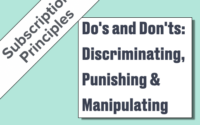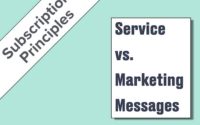How the 2-year price can be higher than twice the 1-year price?
Summary
It’s normal. You just need to look carefully at the price details and take your calculator. Even if the price of the 2-year subscription is more expensive than twice the 1-year subscription, it’s still possible that it’s a better deal.
Last year I was considering changing my online backup subscription. When I reviewed the different plans, I faced a lot of options but, above all, a lot of numbers:
- The price of each subscription option per month, per year
- The promotional price for the first months or first year
- Or the number of months offered
- The renewal price
- The saving compared to…
- And the price for 2 years.
I decided to subscribe. I just had to take the cheapest option. Then, I look at the 2 year price and see that it is more expensive than twice the price for 1 year.🤯
It’s certainly illogical, but before calling it a scam or incompetence, we need to look at the details.
1. The devil is in the detail 👀
First, I look for 2 numbers:
- the subscription price
- and the renewal price for the 1 year option. It’s customary to consider the strike through price as the renewal price, otherwise it’s specified.
Then I look at the price of the 2 year product.
Let’s get out the calculators! 🧮
Here’s a real-life example taken from the web site of an Online Back-Up Service provider : iDrive (as of May 2024). This merchant offers 5 different subscriptions with 1 year and 2 year offers.

Table #1: screen shot from idrive.com (as of May 2024) & footnote
I am interested in the second option: 1 year at $104.65 or 2 years at $224.25. Logically, we would rather expect a 2-year price lower than $209.30 (= 2x $104.65).
Let’s organize the numbers to calculate the cost of the subscription over 2 years.

Table #2: comparing 1-year vs 2-year subscriptions over a 2 year period
In table #2, I add the initial price and the renewal price, which adds up to $254.15 over 2 years. The 2-year offer is priced at $224.25. By taking this option, I save $29.90 over 2 years. 🤑
2. Why don’t we include the retention rate in the calculation?
In the previous article, I showed how the merchant must calculate the 2-year price by including the Retention Rate.
But here, the retention rate no longer matters. As a customer, I know whether I will renew my subscription or not; it’s like my retention rate is 100% or 0%. All you have to do is add the prices for the different periods during which you plan to remain a subscriber.
3. Asterisks and Reality
Very often, we can see a strike through price which suggests we should have paid a certain price or a message like “save up to…”. Here, an asterisk informs me that I can “save 30% on the first year or 50% on the first year by taking the 2-year offer.”
As a customer, I decide whether to subscribe and renew. It is therefore important to only take into consideration the values of what I will actually paid.
Let’s get back to the calculators! 🧮
Let’s look again at table #1, I’m still interested in the second option:
- 1 year at $104.65 and strike through price $149.50
- 2 years at $224.25 and strike through price $299.00
One Year Plan: the strike through price relates to a 30% discount on the 1 year subscription. However, this is not a discount strictly speaking since in no way could I be able to pay $149.50 for the one-year subscription: this price point is not available. 😌
Two Year Plan: if I choose a 2-year subscription, I will pay $224.25 instead of $254.15 with a one-year offer renewed once. I make a real saving of $29.90 or 12% since, in no case, was I able to pay the initial price of $149.50 per year.
The asterisk specifies that we have a 50% discount on the price of the first year if we take the 2-year offer. But the thing about a 2-year offer is that there is only one price for 2 years, so there is no price for the first year. And so, no 50% off discount.
Key Takeaways
- Before subscribing, I note down the prices for each year and consider the strike through prices to be the renewal prices. Then, I do a calculation to estimate the actual savings💰.
- Multi-year subscription offers are real savings opportunities even if the prices may be confusing.
- Striking through a price is not enough to create a saving. I only save compared to what I could have paid. …And remember, if I don’t buy, the saving is 100%.



